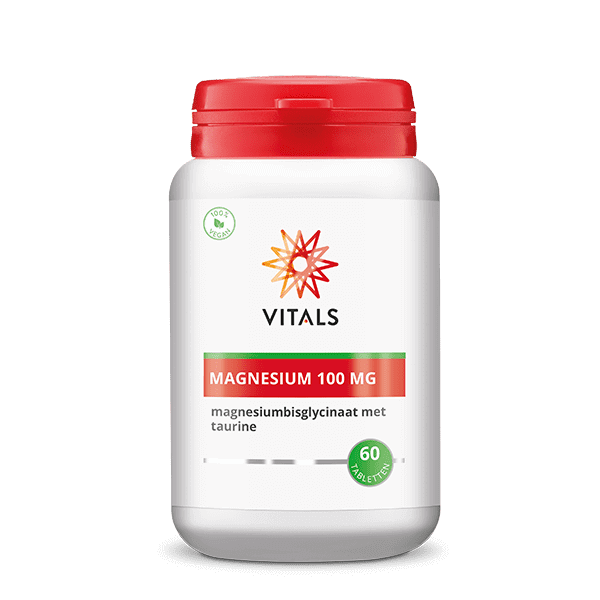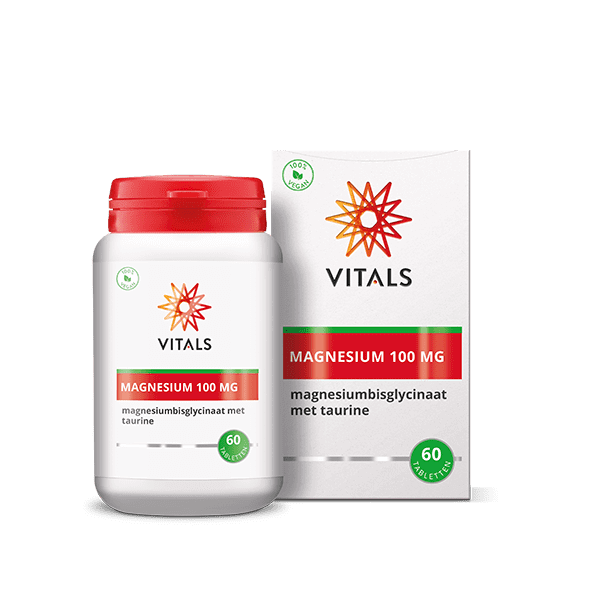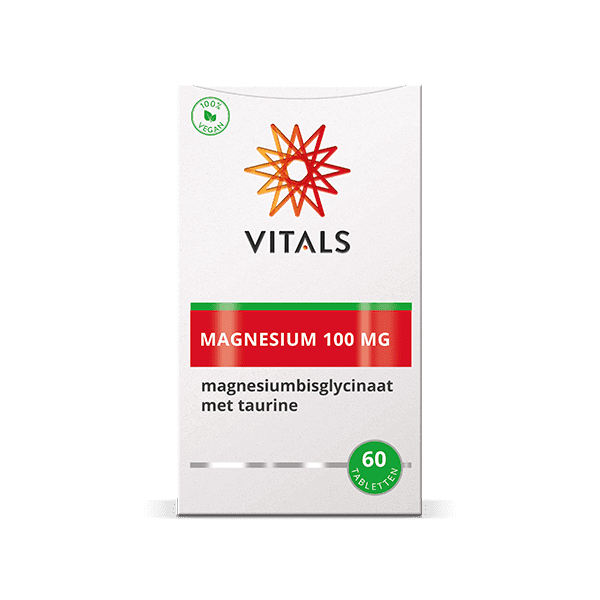VitaFit Labs
VITALS MAGNESIUM 100 MG 60 TABLETS
VITALS MAGNESIUM 100 MG 60 TABLETS
Couldn't load pickup availability
MAGNESIUM 100 MG 60 TABLETS
MAGNESIUM BIS-GLYCINATE WITH TAURINE
- high quality amino acid chelate (magnesium bisglycinate) from Albion Minerals
- with TRAACS® feature (The Real Amino Acid Chelate System)
- compound form with superior bioavailability
- with taurine
EAN: 8716717002689
This product contains magnesium in the form of magnesium bisglycinate. In this case, each magnesium particle is strongly bound (chelated) to two (bis) molecules of the amino acid glycine. The general term for such a compound is amino acid chelate or amino acid chelated mineral. The word 'chelate' comes from the Greek and means 'claw'.
Magnesium is one of the minerals most used in complementary practice. One reason for this is that magnesium plays an important role in more than 300 physiological processes in the body. And despite the fact that many (unprocessed) foods contain magnesium, changes in food production and eating habits have led to many people consuming less magnesium in their diet. Before industrialization, magnesium intake was estimated at 475 to 500 mg per day, today the intake is much lower at 345 mg (average intake per day for adults, according to the latest food consumption survey in the Netherlands). Factors such as stress, high sugar intake and certain medications can also lower magnesium status. This mineral should therefore be considered a basic supplement. And usually there is not much in a multivitamin and mineral preparation, because magnesium takes up a lot of space in a tablet or capsule. Or inferior compound forms are used. It is therefore very important to be aware of the quality differences that exist between magnesium products and to know how to make a good choice.
Inclusion of common mineral compounds
There are several magnesium compounds that are used in supplements. Some of these, such as the inorganic mineral compounds (see Figure 1) magnesium oxide and magnesium carbonate, are not well absorbed and have low bioavailability. When minerals (in any form except amino acid chelated) enter the acidic environment of the stomach, the digestive process begins to disengage the mineral moiety from the chemical structure. As the mineral element continues through the digestive process, it is naturally electrically charged. This charge attracts it to other charged particles such as those found in vegetables, fibers, and fats. These food particles isolate the mineral ions, making them less effective to absorb and utilize by the body. The limited amount of free mineral ions now available continues through the digestive tract, competing with other minerals (such as calcium) for absorption through the intestinal wall and into the cells.
Benefits of Amino Acid Chelated Minerals
In magnesium in the form of magnesium bisglycinate, each magnesium particle is strongly bound (chelated) to two (bis) molecules of the amino acid glycine. This creates a kind of ring structure, with the mineral at the heart of it
The chelate structure in an amino acid chelate such as magnesium bisglycinate is strong enough not to be split by gastric juice or digestive enzymes (as is usually the case with other mineral compounds), but also weak enough so that the mineral element can be freed once it has been absorbed by the cells in the intestine. The amino acids fold around the mineral element and protect it during the digestive process and do not let go. The electrical charge of the chelate is also neutral, so that it does not stick to pieces of food in the stomach and intestines. The amino acid chelate therefore reaches the small intestine in its entirety, where it is absorbed as a dipeptide (a compound with two amino acids). This is very advantageous because the body can absorb amino acids (and in particular dipeptides) extremely easily. Especially if they consist of the amino acid with the smallest size, namely glycine. As a result, amino acid chelated minerals are much better absorbed than other mineral forms. In the epithelial tissue of the jejunum (middle part of the small intestine) the amino acid chelated mineral is brought into the mucous cells by means of active transport without competing with other minerals. Only in the mucous cells do metabolic processes ensure that the glycine and the mineral are split and become available for the various organs and systems in the body.
Amino Acid Chelates from Albion Minerals
Vitals uses only real amino acid chelates from Albion Minerals, the expert in the field of amino acid chelates, recognizable by the trademark TRAACS®, which stands for The Real Amino Acid Chelate System. This brand was created to be able to clearly distinguish itself from other, possibly inferior, unstable amino acid chelates. Albion has registered more than 100 patents worldwide that guarantee the process, science and structure of their amino acid chelated minerals. In addition, research is done with their minerals and quality control is carried out on every batch that is produced. It is essential to check that chelation has actually taken place and that the bonds are strong enough.
Studies with magnesium bisglycinate
There have been several studies that confirm the effectiveness of magnesium bisglycinate. Some of these compared the absorption of magnesium bisglycinate with various magnesium compounds, such as magnesium carbonate, magnesium sulfate and magnesium oxide. Magnesium bisglycinate was absorbed significantly faster and better than the other forms of magnesium. Magnesium oxide performed by far the worst.
Taurine
This product also contains 200 mg taurine. This is an amino acid-like substance that occurs naturally in meat, fish and shellfish. It has a direct synergistic effect with magnesium by promoting the absorption of this mineral in the cells (magnesium is mainly active intracellularly).
How magnesium works in the body
The body contains about 21 to 28 grams of magnesium. Less than 1% circulates in the blood, about 20% is in the muscles, 20% in other soft tissues and the liver and about 60% is incorporated into the bones and teeth. Magnesium is therefore good for the muscles and important for maintaining strong bones and teeth. Furthermore, it is involved in more than 300 enzymatic processes. For example, magnesium is an important co-factor for enzymes involved in protein synthesis (the process in which proteins are created based on DNA). And it also ensures a good electrolyte balance because it is a co-factor for many enzymes that are involved in maintaining an electrical potential across the cell membrane. (Cells – especially nerve and muscle cells – use the electrical charge of electrolytes to conduct electrical impulses to and from other cells, such as nerve impulses or muscle contractions.) In this way, magnesium is involved in nerve conduction and muscle contraction, and is therefore important for muscle function, including the heart muscle. In addition, an insufficient magnesium intake can lead to fatigue. In this case, magnesium can help to get fit again. It helps to release energy from fats, carbohydrates and proteins and thus supports energy levels. It is also important for brain and nerve functions that determine aspects such as concentration, memory and mood. And it contributes to normal cell division and the production of cells and tissues.
Permitted health claims:
- magnesium can help with fatigue
- magnesium supports energy levels
- magnesium is important for normal muscle function and plays a role in maintaining supple and strong muscles
- magnesium plays a role in the production of cells and tissues
- magnesium helps build proteins in the body
- magnesium is involved in bone formation and is important for maintaining strong bones and teeth
- magnesium is good for mood, concentration and memory
- magnesium has a positive effect on the functioning of the nervous system
- magnesium contributes to a good electrolyte balance
|
Composition per tablet: |
RI* | |
| Magnesium (bisglycinate, TRAACS®) | 100 mg | 27% |
| Taurine | 200 mg | - |
|
Composition per 2 tablets: |
RI* | |
| Magnesium (bisglycinate, TRAACS®) | 200 mg | 54% |
| Taurine | 400 mg | - |
* RI = Reference intake
TRAACS® (The Real Amino Acid Chelate System) is a registered trademark of Albion Minerals.
Ingredients:
Magnesium bisglycinate, bulking agent (microcrystalline cellulose [cellulose gel]), taurine, rapeseed oil (Brassica napus), thickener (hydroxypropyl cellulose), anti-caking agents (silicon dioxide, magnesium salts of fatty acids), glazing agents (hydroxypropyl methylcellulose, glycerol, hydroxypropyl cellulose).
Suitable for vegetarians and vegans.

Magnesium bisglycinate, bulking agent (microcrystalline cellulose [cellulose gel]), taurine, rapeseed oil (Brassica napus), thickener (hydroxypropyl cellulose), anti-caking agents (silicon dioxide, magnesium salts of fatty acids), glazing agents (hydroxypropyl methylcellulose, glycerol, hydroxypropyl cellulose).









